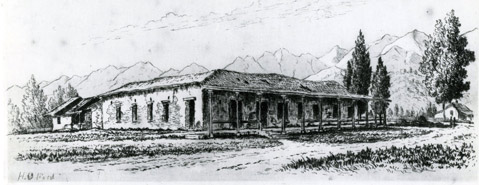The Old Aguirre Adobe
Nineteen-Room Home Most Impressive in S.B.

The adobe’s builder, José Antonio Aguirre, was born in the Basque country of northeastern Spain about 1795. By the early 1820s, he was a successful Mexico City merchant, who owned several ships that traded between China, the Philippines, Mexico, and California. When Mexico broke away from Spain in the 1820s, Aguirre remained loyal to Spain, left Mexico, and settled in San Diego. In 1838, he moved to Santa Barbara. Shortly thereafter, he began to build a house about where the Little Town Club is today, at 27 East Carrillo Street.
It was one of the most impressive homes in Santa Barbara. The 19-room house formed a quadrangle around a large central courtyard. The home had one of the few wooden floors in Santa Barbara, and the windows were fitted with glass, highly unusual for that period. The living room was 30 feet long and boasted three crystal chandeliers. Aguirre outfitted the house with furniture of the finest craftsmanship, and beautiful frescos adorned the walls. The adobe sat upon an elevated stone foundation, and a stone wall surrounded the property. The courtyard had a well and was enhanced with fruit trees and flower gardens.
In 1842, Aguirre married María Francisca Estefana Estudillo of a prominent San Diego family. One of the first guests they welcomed to their new home was Bishop Francisco García Diego y Moreno, who had just transferred his residence from San Diego to Santa Barbara. Tragically, the newlyweds were to have a very short life together, for in October, Maria passed away.
Nonetheless, Aguirre continued to prosper in business. In 1843, he became co-grantee of Rancho El Tejon, nearly 98,000 acres, in what is today Kern County. In 1846, he married María del Rosario Estudillo, a sister of his first wife. That same year, she was granted a rancho of some 49,000 acres in present-day Riverside County. Aguirre turned a portion of his Santa Barbara home into a general store and engaged Agustín Janssens, a former business partner, to run it. Janssens would later use the adobe as one of Santa Barbara’s first post offices.
In 1845, torrential rains filled the adobe’s courtyard and partially flooded the house. The walls absorbed a great deal of water, and this began a slow decline of the house. By the 1850s, Aguirre was dividing his time between Santa Barbara and San Diego. He died in San Diego about 1860.
In ensuing years, the adobe was put to a number of uses. It served as the county’s first courthouse from 1850-1853. The Sisters of Charity, who later established St. Vincent’s Orphanage, used the adobe for a school upon their arrival in Santa Barbara in 1858. During the Civil War, part of the building was used as an armory. A number of Protestant congregations met here during the 1860s and ’70s, and during the ’70s, the adobe also served as an election polling place.
By the early 1880s, the building had fallen into total disrepair and was razed in 1884. All that is left of what was once a most elegant home are the carved wooden porch columns that now adorn a building at 800 Santa Barbara Street.



